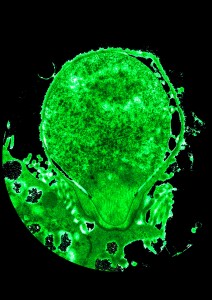 Not all microbes are beneficial to us: this image is of a pathogen called Cryptosporidium shortly after it invaded a gut cell causing watery diarrhoea, vomiting, stomach pains, and fever, with potentially serious consequences for children and people with weak immune systems. Cryptosporidium multiplies within the host – which could be animal or human – to produce millions of tiny “oocysts” which are shed in faeces. These oocysts become spread throughout the environment and can reach the lakes, rivers and streams we rely upon for drinking water and recreation. Cryptosporidium is of particular concern to water companies as it cannot be controlled in drinking water through traditional water disinfection.
Not all microbes are beneficial to us: this image is of a pathogen called Cryptosporidium shortly after it invaded a gut cell causing watery diarrhoea, vomiting, stomach pains, and fever, with potentially serious consequences for children and people with weak immune systems. Cryptosporidium multiplies within the host – which could be animal or human – to produce millions of tiny “oocysts” which are shed in faeces. These oocysts become spread throughout the environment and can reach the lakes, rivers and streams we rely upon for drinking water and recreation. Cryptosporidium is of particular concern to water companies as it cannot be controlled in drinking water through traditional water disinfection.
We have found human Cryptosporidium oocysts in fish, indicating that transfer of this pathogen may occur through rivers in ways not investigated previously; aquatic animals may act as transport vectors. This new information will be included with other DURESS data to estimate, using catchment modelling, how risks of Cryptosporidium contamination and infection might change when land use changes. This in turn will be used to help make decisions about reducing public health risks when considering changes to land use.
